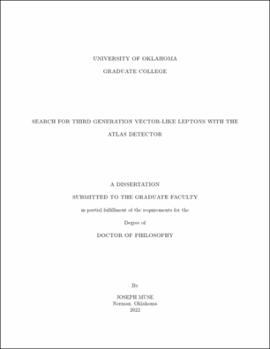| dc.contributor.advisor | Gutierrez, Phillip | |
| dc.contributor.author | Muse, Joseph | |
| dc.date.accessioned | 2022-03-10T18:21:45Z | |
| dc.date.available | 2022-03-10T18:21:45Z | |
| dc.date.issued | 2022-03-09 | |
| dc.identifier.uri | https://hdl.handle.net/11244/334960 | |
| dc.description.abstract | The Standard Model of particle physics provides a concise description of the building blocks of our universe in terms of fundamental particles and their interactions. It is an extremely successful theory, providing a plethora of predictions that precisely match experimental observation. In 2012, the Higgs boson was observed at CERN and was the last particle predicted by the Standard Model that had yet-to-be discovered. While this added further credibility to the theory, the Standard Model appears incomplete. Notably, it only accounts for 5% of the energy density of the universe (the rest being ``dark matter'' and ``dark energy''), it cannot resolve the gravitational force with quantum theory, it does not explain the origin of neutrino masses and cannot account for matter/anti-matter asymmetry. The most plausible explanation is that the theory is an approximation and new physics remains.
Vector-like leptons are well-motivated by a number of theories that seek to provide closure on the Standard Model. They are a simple addition to the Standard Model and can help to resolve a number of discrepancies without disturbing precisely measured observables. This thesis presents a search for vector-like leptons that preferentially couple to tau leptons. The search was performed using proton-proton collision data from the Large Hadron Collider collected by the ATLAS experiment from 2015 to 2018 at center-of-mass energy of 13 TeV, corresponding to an integrated luminosity of 139 inverse femtobarns. Final states of various lepton multiplicities were considered to isolate the vector-like lepton signal against Standard Model and instrumental background. The major backgrounds mimicking the signal are from WZ, ZZ, tt+Z production and from mis-identified leptons. A number of boosted decision trees were used to improve rejection power against background where the signal was measured using a binned-likelihood estimator. No excess relative to the Standard Model was observed. Exclusion limits were placed on vector-like leptons in the mass range of 130 to 898 GeV. | en_US |
| dc.language | en_US | en_US |
| dc.subject | Particle Physics | en_US |
| dc.subject | ATLAS Experiment | en_US |
| dc.subject | Vector-like Leptons | en_US |
| dc.subject | Machine Learning | en_US |
| dc.title | Search for third generation vector-like leptons with the ATLAS detector | en_US |
| dc.contributor.committeeMember | Abbott, Braden | |
| dc.contributor.committeeMember | Sinha, Kuver | |
| dc.contributor.committeeMember | Leighly, Karen | |
| dc.contributor.committeeMember | Kornelson, Keri | |
| dc.date.manuscript | 2022-03-09 | |
| dc.thesis.degree | Ph.D. | en_US |
| ou.group | Dodge Family College of Arts and Sciences::Homer L. Dodge Department of Physics and Astronomy | en_US |
| shareok.orcid | 0000-0002-2585-3793 | en_US |
